#scalable NoSQL
Explore tagged Tumblr posts
Text
Discover the advantages of scalable NoSQL databases for modern applications. Built for flexibility, exceptional performance, and the ability to manage extensive workloads, NoSQL databases are well-suited for real-time data processing and evolving business requirements. Explore how these databases enable seamless scalability, empowering organizations to excel in today’s data-driven landscape.
0 notes
Text






#DidYouKnow NoSQL Databases Enable Big Data Handling
Swipe left to explore!
To learn more about NOSQL Database Management Click Here 👉 https://simplelogic-it.com/nosql-database-management/
💻 Explore insights on the latest in #technology on our Blog Page 👉 https://simplelogic-it.com/blogs/
🚀 Ready for your next career move? Check out our #careers page for exciting opportunities 👉 https://simplelogic-it.com/careers/
#didyouknowfacts#knowledgedrop#interestingfacts#factoftheday#learnsomethingneweveryday#mindblown#didyouknowthat#triviatime#learnsomethingnew#nosql#nosqldatabase#databse#data#unstructureddata#analytics#iot#scalable#application#makeitsimple#simplelogicit#simplelogic#makingitsimple#itservices#itconsulting
0 notes
Text
Data Unbound: Embracing NoSQL & NewSQL for the Real-Time Era.
Sanjay Kumar Mohindroo Sanjay Kumar Mohindroo. skm.stayingalive.in Explore how NoSQL and NewSQL databases revolutionize data management by handling unstructured data, supporting distributed architectures, and enabling real-time analytics. In today’s digital-first landscape, businesses and institutions are under mounting pressure to process massive volumes of data with greater speed,…
#ACID compliance#CIO decision-making#cloud data platforms#cloud-native data systems#column-family databases#data strategy#data-driven applications#database modernization#digital transformation#distributed database architecture#document stores#enterprise database platforms#graph databases#horizontal scaling#hybrid data stack#in-memory processing#IT modernization#key-value databases#News#NewSQL databases#next-gen data architecture#NoSQL databases#performance-driven applications#real-time data analytics#real-time data infrastructure#Sanjay Kumar Mohindroo#scalable database solutions#scalable systems for growth#schema-less databases#Tech Leadership
0 notes
Text
#MongoDB#DatabaseManagement#NoSQL#DataSecurity#PerformanceOptimization#TechUpdates#SoftwareDevelopment#DataEncryption#Scalability#LiveResharding
0 notes
Text
What is Mern stack And Its importance? Before that I will Tell you the best institute for Mern stack course in Chandigarh.

What is Mern stack?
MERN Stack is a popular JavaScript-based technology stack used for building full-stack web applications. It consists of four key technologies:
MongoDB: A NoSQL database that stores data in a flexible, JSON-like format.
Express.js: A lightweight and fast backend framework for Node.js.
React.js: A front-end JavaScript library for building user interfaces.
Node.js: A runtime environment that allows JavaScript to run on the server side.
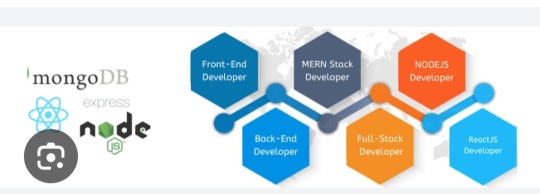
Importance of Mern Stack :
Full-Stack JavaScript – Uses JavaScript for frontend and backend, simplifying development.
High Performance – Node.js ensures fast, scalable applications.
Cost-Effective – Open-source, reducing development costs.
Rapid Development – React’s reusable components speed up UI building.
Flexibility – Suitable for web apps, SPAs, eCommerce, and real-time applications.
Scalability – MongoDB handles large data efficiently.
Strong Community Support – Large developer base ensures continuous updates and support.
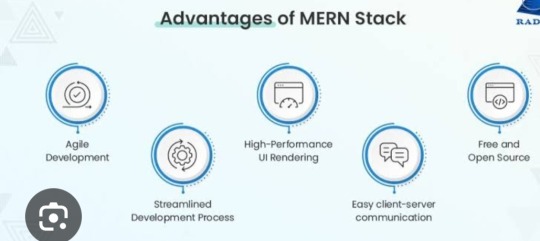
Now i will tell you the best institute for Mern stack course in Chandigarh .
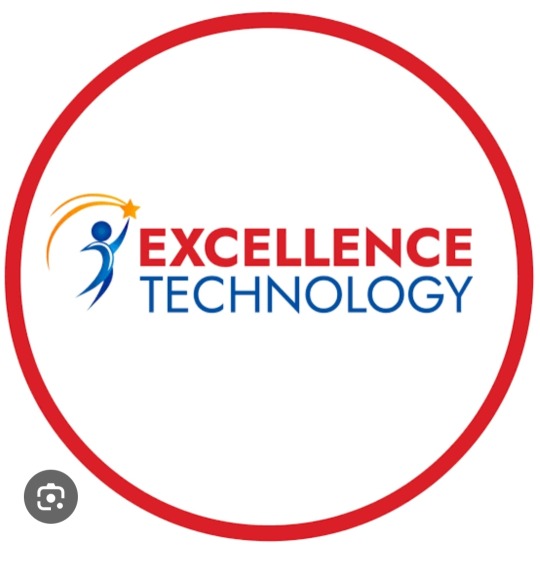
Excellence Technology is a leading EdTech (Educational technology) company dedicated to empowering individuals with cutting -edge IT skills and bridging the gap between education and industry demands. Specializing in IT training ,carrer development, and placement assistance ,the company equipts learners with the technical expertise and practical experience needed to thrive in today's competitive tech landscape. We provide IT courses like python ,Full stack Development, Web Design ,Graphic Design and Digital Marketing.
Contact Us for more details: 93177-88822
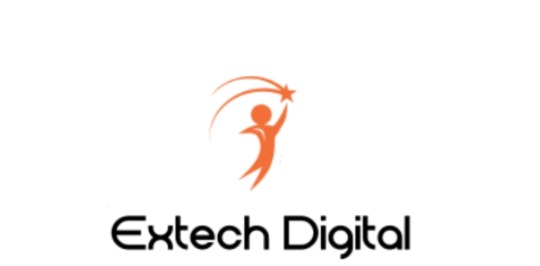
Extech Digital is a leading software development company dedicated to empowering individuals with cutting -edge IT skills and bridging the gap between education and industry demands. Specializing in IT training ,carrer development, and placement assistance ,the company equipt learners with the technical expertise and practical experience needed to thrive in today's competitive tech landscape. e provide IT courses like Python ,Full stack Development, Web Design ,Graphic Design and Digital Marketing.
Contact Us for more details: 93177-88822

Excellence academy is a leading software development company dedicated to empowering individual with cutting edge IT skills and bridging the gap between education and industry demands.specializing in IT training, career development, and placement assistance, the company equits learners with the technical expertise and practical experience needed to thrive in today's landscape. We provide IT courses like python, full stack development,Web design, and Digital marketing.
Contact Us for more details: 93177-88822
About Author
Nikita Thakur
Mern stack AI Developer/ 2+ years of experience
Excellence technology
Professional summary
Nikita thakur is a skilled MERN Stack AI Developer with over 2 years of experience at Excellence Technology. Proficient in MongoDB, Express.js, React.js, and Node.js, she integrates AI solutions to build scalable, high-performance web applications. Nikita excels in developing innovative solutions, enhancing user experiences, and driving business growth through technology.
2 notes
·
View notes
Text
Binance clone script — Overview by BlockchainX
A Binance Clone Script is a pre-built, customizable software solution that replicates Binance's features, connect with BlockchainX
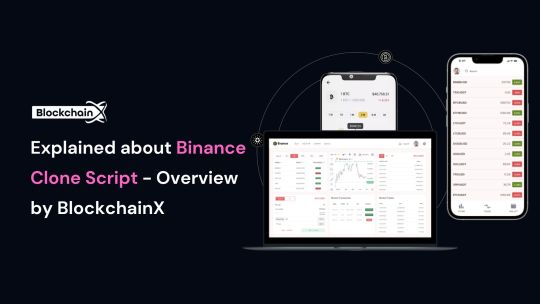
What is Binance Clone Script
A Binance clone script refers to the ready-made solution of the Binance platform that deals with core functions parallel to the widely acclaimed cryptocurrency exchange platform associated with Binance. It enables companies to establish their own platforms like Binance, perfectly parameterized in terms of functionality and user interface of world-famous exchanges. The clone script provides display flexibility with built-in functionality such as spot trading software, futures trading configurations, and wallet systems that are extremely secure.
Basically, it reduces development costs and latency because things like these are already built. And as this is a startup for many young entrepreneurs, they can have saved on their capital to expand or grow their business.
The script is blessed as its feature set caters to future demands in the field. One can enjoy a safe trading experience to customers while ensuring that every peculiarity of Binance’s success opens up to investors of the script.
How does the Binance clone script work?
The Binance clone script works to provide a ready-made platform that replicates Binance’s core features, such as user registration, wallet management, trade and enables users to create accounts, deposit or withdraw cryptocurrency, and trade digital assets through an interface easily and safely. The platform supports various trading methods such as market orders, limit orders and forward trading. It has built-in security features like two-factor authentication (2FA) to save the user money. Admin dashboards allow platform owners to manage users, manage tasks, and set up billing. The script can be tailored to your brand, connecting liquidity sources to make trading more efficient. In short, the Binance clone script provides everything needed to create a fully functional crypto exchange.
key features of a Binance Clone Script
The key features of a Binance Clone Script are designed to make your cryptocurrency exchange platform secure, user-friendly, and fully functional. Here’s a simple overview of these features:
User-Friendly Interface
Multi-Currency Support
Advanced Trading Engine
Secure Wallet System
KYC/AML Integration
Admin Dashboard
Security Features
Trading Options
These features help ensure that your Binance-like exchange is efficient, secure, and ready for the growing crypto market.
Technology Stack Used by BlockchainX
Technology stack used for developing the Binance clone script involves the most advanced technology combination that ensures that the platform must have so much security, scalability, and performance to make it a platform that is secure, scalable, and high-performance as well. Here are a few key technologies and their brief descriptions:
Blockchain Technology:
The underlying part of the cryptocurrency exchange is Blockchain because it ensures the safe and decentralized processing of transactions.
Normally executed on either Ethereum or BSC (Binance Smart Chain) to carry out smart contracts and token transfers.
Programming Languages:
Frontend: For frontend, React or Angular could be engaged in actualization of the user interface leading to a responsive and interactive experience on the various devices.
Backend: In backend, languages like Node.js, Python, or Ruby on Rails can be applied on how internal logic is being run by server and arbitration of user interaction with the module is foremost.
Databases:
These two databases, MySQL or Postgresql, are typically used in user information storage, transaction records, and other exchange information.
NoSQL such as MongoDB or other databases might be used for horizontal scalability and high-volume transaction storage.
Smart Contracts:
It is used to generate and send out smart contracts for auto-trading, token generation, and other decentralized functionalities.
Blockchain Wallets:
Fundamentally, this automatically links famous wallet systems such as MetaMask, Trust Wallet, or Ledger for the secure storage and transactions of cryptocurrency.
Advantages of using a Binance Clone Script
Here are the advantages of using a Binance Clone Script:
Faster Time-to-Market
Cost-Effective
Customizable Features
Liquidity Integration
Multiple Trading Options
So, when entering the marketplace of the cryptocurrencies it would be the most possible work of something to pay off at a rapid pace: the Binance Clone Script proves so.
How to Get Started with BlockchainX’s Binance Clone Script
It is quite a straightforward process to begin working with a BlockchainX Binance Clone Script-this involves the first step of getting in touch with the company for an initial consulting period to understand more about what you require, need, or customize for the site, and what your goals are. When BlockchainX has an understanding of your needs, they offer a detailed list of what a proposal would entail before they can start the work; afterward, they will estimate the costs needed to do the project. Once both sides accept both the presentations and all features and timelines are agreed with, BlockchainX starts working on the development process of building a Binance Clone Script tailored to the brand, user interface, and other features.
After the entire platform is created, it passes through severe testing to ensure that everything functions excellently. Deployment follows the thorough test. BlockchainX customizes your user interface and more extensions, after deployment. BlockchainX also commits to supporting and sustaining your exchange so that it runs successfully and securely.
Conclusion:
At the end, your confusion may as well be cut short. Yes, the Binance Clone Script will be a resilient solution to spark up the exchange platforms synthesizing user-generated cryptocurrency dreams in the blockchain, even without bankroll when it comes to developing the app. Turning with BlockchainX expertise, you can make an adjustment and scale a powerful platform stocked with the likes of Binance that produced Blockchains, while still containing some specific set-ups for your masterpiece. More amazing features are exclusive to the clone script, moreover, such as support for multiple currencies, high-end security, real-time data, and a smooth user interface that completes the trading process for your users without any glitch.
This solution gives easy access to ready-made solutions. It could have quality Depending on the time you conveniently let BlockchainX’s be and use both exchanges or any variation of the two permutations. After all, who decides to couple up with a one-experienced Crypto Exchange developer who is struggling to offer anything new.
#binance clone script#binance clone script development#binance clone script development service#blockchain technology#blockchain#cryptocurrency#cryptocurrencies
2 notes
·
View notes
Text
The Roadmap to Full Stack Developer Proficiency: A Comprehensive Guide
Embarking on the journey to becoming a full stack developer is an exhilarating endeavor filled with growth and challenges. Whether you're taking your first steps or seeking to elevate your skills, understanding the path ahead is crucial. In this detailed roadmap, we'll outline the stages of mastering full stack development, exploring essential milestones, competencies, and strategies to guide you through this enriching career journey.

Beginning the Journey: Novice Phase (0-6 Months)
As a novice, you're entering the realm of programming with a fresh perspective and eagerness to learn. This initial phase sets the groundwork for your progression as a full stack developer.
Grasping Programming Fundamentals:
Your journey commences with grasping the foundational elements of programming languages like HTML, CSS, and JavaScript. These are the cornerstone of web development and are essential for crafting dynamic and interactive web applications.
Familiarizing with Basic Data Structures and Algorithms:
To develop proficiency in programming, understanding fundamental data structures such as arrays, objects, and linked lists, along with algorithms like sorting and searching, is imperative. These concepts form the backbone of problem-solving in software development.
Exploring Essential Web Development Concepts:
During this phase, you'll delve into crucial web development concepts like client-server architecture, HTTP protocol, and the Document Object Model (DOM). Acquiring insights into the underlying mechanisms of web applications lays a strong foundation for tackling more intricate projects.
Advancing Forward: Intermediate Stage (6 Months - 2 Years)
As you progress beyond the basics, you'll transition into the intermediate stage, where you'll deepen your understanding and skills across various facets of full stack development.
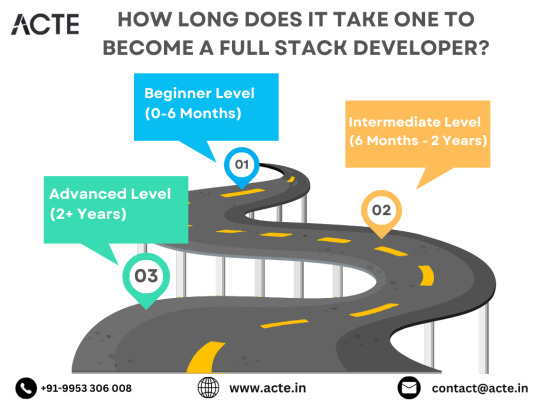
Venturing into Backend Development:
In the intermediate stage, you'll venture into backend development, honing your proficiency in server-side languages like Node.js, Python, or Java. Here, you'll learn to construct robust server-side applications, manage data storage and retrieval, and implement authentication and authorization mechanisms.
Mastering Database Management:
A pivotal aspect of backend development is comprehending databases. You'll delve into relational databases like MySQL and PostgreSQL, as well as NoSQL databases like MongoDB. Proficiency in database management systems and design principles enables the creation of scalable and efficient applications.
Exploring Frontend Frameworks and Libraries:
In addition to backend development, you'll deepen your expertise in frontend technologies. You'll explore prominent frameworks and libraries such as React, Angular, or Vue.js, streamlining the creation of interactive and responsive user interfaces.
Learning Version Control with Git:
Version control is indispensable for collaborative software development. During this phase, you'll familiarize yourself with Git, a distributed version control system, to manage your codebase, track changes, and collaborate effectively with fellow developers.
Achieving Mastery: Advanced Phase (2+ Years)
As you ascend in your journey, you'll enter the advanced phase of full stack development, where you'll refine your skills, tackle intricate challenges, and delve into specialized domains of interest.
Designing Scalable Systems:
In the advanced stage, focus shifts to designing scalable systems capable of managing substantial volumes of traffic and data. You'll explore design patterns, scalability methodologies, and cloud computing platforms like AWS, Azure, or Google Cloud.
Embracing DevOps Practices:
DevOps practices play a pivotal role in contemporary software development. You'll delve into continuous integration and continuous deployment (CI/CD) pipelines, infrastructure as code (IaC), and containerization technologies such as Docker and Kubernetes.
Specializing in Niche Areas:
With experience, you may opt to specialize in specific domains of full stack development, whether it's frontend or backend development, mobile app development, or DevOps. Specialization enables you to deepen your expertise and pursue career avenues aligned with your passions and strengths.
Conclusion:
Becoming a proficient full stack developer is a transformative journey that demands dedication, resilience, and perpetual learning. By following the roadmap outlined in this guide and maintaining a curious and adaptable mindset, you'll navigate the complexities and opportunities inherent in the realm of full stack development. Remember, mastery isn't merely about acquiring technical skills but also about fostering collaboration, embracing innovation, and contributing meaningfully to the ever-evolving landscape of technology.
#full stack developer#education#information#full stack web development#front end development#frameworks#web development#backend#full stack developer course#technology
9 notes
·
View notes
Text
Jclicksolutions Launches MERN Stack Training in Nagercoil: Empowering Aspiring Full-Stack Developers
The demand for skilled web developers continues to rise as businesses across industries move online. To meet this growing need, Jclicksolutions is excited to offer an intensive MERN Stack training program in Nagercoil, providing aspiring developers and professionals with the essential skills to build full-stack web applications. This program focuses on the MERN Stack, a popular framework that uses JavaScript across both front-end and back-end development, making it an ideal solution for dynamic and scalable applications.
What is the MERN Stack?
The MERN Stack is a combination of four powerful technologies:
MongoDB: A NoSQL database, perfect for handling and managing large amounts of data with flexibility and ease.
Express.js: A fast and minimalist web framework for Node.js, used to build robust server-side applications.
React.js: A highly efficient JavaScript library developed by Facebook for creating interactive user interfaces.
Node.js: A runtime environment that allows JavaScript to be used for server-side scripting, enabling full-stack development using a single language.
The MERN Stack is one of the most sought-after development frameworks due to its versatility, scalability, and widespread use in the industry. Companies across the globe are adopting MERN Stack for building responsive and efficient web applications, creating a significant demand for developers proficient in this framework.
Why Choose Jclicksolutions in Nagercoil?
JClickSolutions is a leading IT training provider, known for delivering industry-relevant programs that prepare students for real-world challenges. The MERN Stack course in Nagercoil offers several unique benefits:
Comprehensive Curriculum: The course covers all core elements of the MERN Stack, providing in-depth training on MongoDB, Express, React, and Node.js. Participants will gain practical experience in front-end and back-end development, enabling them to build complete web applications from scratch.
Hands-on Learning: The training is project-based, giving students the opportunity to work on real-world applications. By building live projects, participants will develop practical skills and a strong portfolio that showcases their expertise.
Expert Instructors: Jclicksolutions' MERN Stack training is led by experienced developers with years of experience in full-stack development. They provide personalized guidance and mentorship, helping students understand the nuances of each technology.
Flexible Learning Options: The course offers flexible schedules, including both online and in-person classes, catering to students, working professionals, and tech enthusiasts. This allows participants to learn at their own pace while balancing other commitments.
Career Support: Jclicksolutions provides end-to-end career support, including resume building, interview preparation, and job placement assistance. Graduates of the MERN Stack program are well-prepared to enter the job market and secure positions in top tech companies.
The Growing Demand for MERN Stack Developers
The rise of web-based applications has increased the demand for full-stack developers proficient in frameworks like MERN. With companies looking for scalable, high-performance solutions, MERN Stack has become a go-to choice for building modern web applications. Learning the MERN Stack opens up numerous job opportunities, from startups to large enterprises.
Why Nagercoil?
As a growing tech hub, Nagercoil is witnessing increased investment in IT and software development sectors. Jclicksolutions' decision to offer MERN Stack training in Nagercoil comes at a perfect time, giving local talent the opportunity to develop skills without relocating to larger cities. The course provides a gateway to lucrative career options in web development, both locally and globally.
Conclusion
The MERN Stack training program at Jclicksolutions in Nagercoil is the perfect stepping stone for anyone looking to build a successful career in web development. With its industry-aligned curriculum, hands-on projects, and expert mentorship, participants will gain the skills and confidence needed to excel in today’s competitive tech landscape.
For more details or to register, visit www.jclicksolutions.in today!
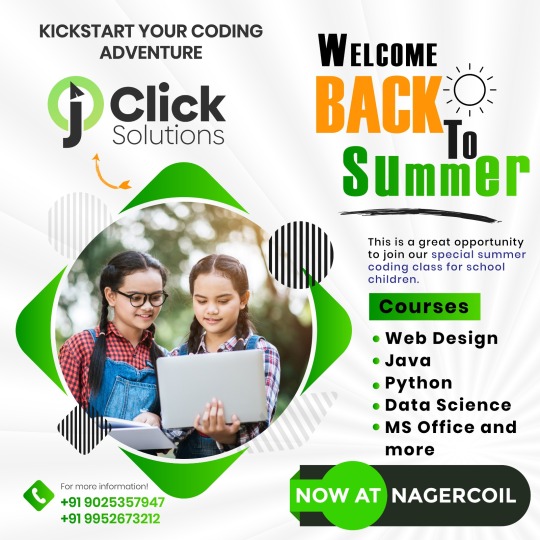
#MERN STACK in Nagercoil
#MERNSTACKinNagercoil
#Jclicksolutions
#JclicksolutionsMERNSTACKinNagercoil
2 notes
·
View notes
Text
Top 5 Common Database Design patterns in Laravel
In the world of Laravel development, a well-structured database is the bedrock of a robust and scalable application. While Laravel's Eloquent ORM provides a powerful abstraction layer for interacting with your data, understanding common database design patterns can significantly enhance your development process.
These patterns not only promote code organization and maintainability but also enable you to adapt your database structure to the unique needs of your application. By mastering these patterns, you can build efficient, reliable, and easily maintainable Laravel applications that can handle diverse data requirements.
1. Active Record Pattern:
This is the most common pattern used by Eloquent ORM in Laravel. It encapsulates database logic within model classes, allowing you to interact with the database using object-oriented methods.
Application
This pattern is well-suited for projects of any size and complexity. It simplifies database operations, making them easier to understand and maintain.
Example:

Advantages:
Simplicity: Easy to understand and implement.
Code Reusability: Model methods can be reused throughout your application.
Relationship Management: Built-in support for relationships between models.
Disadvantages:
Tight Coupling: Model logic is tightly coupled to the database, making it harder to test independently.
Complexity: Can become complex for large applications with complex data structures.
2. Data Mapper Pattern:
This pattern separates data access logic from domain logic. It uses a dedicated "mapper" class to translate between domain objects and database records.
Application
This pattern is useful for large-scale applications with complex domain models, as it allows for greater flexibility and modularity. It is particularly useful when working with multiple data sources or when you need to optimize for performance.
Example:

Advantages:
Flexibility: Easily change the database implementation without affecting business logic.
Testability: Easy to test independently from the database.
Modularity: Promotes a modular structure, separating concerns.
Disadvantages:
Increased Complexity: Requires more code and might be overkill for simple applications.
3. Repository Pattern:
This pattern provides an abstraction layer over the data access mechanism, offering a consistent interface for interacting with the database.
Application
This pattern promotes loose coupling and simplifies testing, as you can easily mock the repository and control the data returned. It is often used in conjunction with the Data Mapper pattern.
Example:

Advantages:
Loose Coupling: Decouples business logic from specific data access implementation.
Testability: Easy to mock repositories for testing.
Reusability: Reusable interface for accessing different data sources.
Disadvantages:
Initial Setup: Can require more setup compared to Active Record.
4. Table Inheritance Pattern:
This pattern allows you to create a hierarchical relationship between tables, where child tables inherit properties from a parent table.
Application
This pattern is useful for creating polymorphic relationships and managing data for different types of entities. For example, you could have a User table and separate tables for AdminUser and CustomerUser that inherit from the parent table.
Example:

Advantages:
Polymorphism: Enables handling different types of entities using a common interface.
Code Reusability: Reuses properties and methods from the parent table.
Data Organization: Provides a structured way to organize data for different types of users.
Disadvantages:
Increased Database Complexity: Can lead to a more complex database structure.
5. Schema-less Database Pattern:
This pattern avoids the use of a predefined schema and allows for dynamic data structures. This is commonly used with NoSQL databases like MongoDB.
Application
This pattern is suitable for projects that require highly flexible data structures, such as social media platforms or analytics systems.
Example:

Advantages:
Flexibility: Easily adapt to changing data structures.
Scalability: Suitable for high-volume, rapidly changing data.
High Performance: Efficient for specific use cases like real-time analytics.
Disadvantages:
Increased Complexity: Requires a different approach to querying and data manipulation.
Data Consistency: Can be challenging to maintain data consistency without a schema.
Choosing the Right Pattern:
The best pattern for your project depends on factors like project size, complexity, performance requirements, and your team's experience. It is important to choose patterns that align with the specific needs of your application and ensure long-term maintainability and scalability.
Conclusion:
This exploration of common database design patterns used in Laravel has shed light on the importance of strategic database structuring for building robust and scalable applications. From the simplicity of the Active Record pattern to the sophisticated capabilities of the Data Mapper and Repository patterns, each pattern offers distinct benefits that cater to specific project needs.
By understanding the strengths and applications of these patterns, Laravel developers can choose the optimal approach for their projects, ensuring a well-organized, efficient, and maintainable database architecture. Ultimately, mastering these patterns empowers you to create Laravel applications that are not only functional but also adaptable to evolving data requirements and future growth.
#laravel#laravel development company#laravel framework#laravel developers#database#design#coding#programming
4 notes
·
View notes
Text
Transform Your Career with Our Live Full Stack MERN Course on StuIntern!
Are you eager to become a full-stack web developer and master the latest technologies? StuIntern.com is very thrilled to introduce our Live Full Stack MERN Developer Course crafted to equip you with the skills & the knowledge needed to excel in the tech industry. With a focus on hands-on learning & the real-world applications, this course is your gateway to becoming a proficient full-stack developer using the MERN stack.
Why Enroll in Our Live Full Stack MERN Course?
1. Comprehensive Curriculum: Our course covers the entire MERN stack—MongoDB, Express.js, React, and Node.js—ensuring you acquire a thorough understanding of how each of them function together. Some areas that would be covered include:
MongoDB: Learn to design & then manage databases using this powerful NoSQL database.
Express.js: Understand how to build scalable web applications & the APIs with this minimalist web framework for Node.js.
React: Master the art of creating dynamic & the responsive user interfaces with this popular JavaScript library.
Node.js: Gain expertise in server-side JavaScript and learn to create robust back-end solutions.
2. Expert Instructors: Our instructors are professionals from industry who have spent years of their lives acquiring deep technical knowledge as well as experience. This will enable them to give insights that are practical in nature so that you can know what best practices are as well as advanced techniques provided by actual experts.
3. Real-World Projects: With our project-based approach, put your skills into practice in real scenarios. This will involve working on practical assignments as well as building full-stack applications from scratch which will give you skills that are valuable in future employment opportunities.
4. Interactive Live Sessions: Our live classes offer an opportunity for direct communication between tutors and students. It aids instant feedback and dynamic discussions while deepening their understanding of complex concepts.
5. Affordable Pricing: At StuIntern.com, we believe quality education should be accessible. Our MERN Stack Development Course is priced competitively, offering exceptional value without compromising on content or support. Flexible payment options are available to suit your budget.
6. Lifetime Access: Enroll once and have lifetime access to everything including course session recordings, code samples, other resources etc. Get back at the material when you want or learn about stuff you missed earlier.
Course Highlights
Hands-On Learning: Build and deploy your own full-stack applications.
Expert Guidance: Receive mentorship and support from experienced developers.
Career Preparation: Gain practical skills and a portfolio of projects to showcase to potential employers.
Flexible Schedule: Join live sessions at times that fit your schedule, with recordings available for review.
How to Enroll
1. Visit StuIntern.com: Navigate to the MERN Stack Course page.
2. Select Your Plan: Choose the course package that aligns with your learning goals and budget.
3. Register Online: Fill out the registration form and complete your payment through our secure system.
4. Get Started: Receive all the necessary details to join live sessions and access course materials.
Don’t Wait—Transform Your Future Today!
Step forward in web development skill and create a path to a bright career with our Live MERN Stack Developer Course. Reserve your s-eat now because space is limited and start your journey to becoming an accomplished full-stack developer.
For further information, or to register go to StuIntern.com and take the first step in mastering the MERN stack.
StuIntern.com—Empowering Your Tech Career with Excellence!
4 notes
·
View notes
Text
java full stack
A Java Full Stack Developer is proficient in both front-end and back-end development, using Java for server-side (backend) programming. Here's a comprehensive guide to becoming a Java Full Stack Developer:
1. Core Java
Fundamentals: Object-Oriented Programming, Data Types, Variables, Arrays, Operators, Control Statements.
Advanced Topics: Exception Handling, Collections Framework, Streams, Lambda Expressions, Multithreading.
2. Front-End Development
HTML: Structure of web pages, Semantic HTML.
CSS: Styling, Flexbox, Grid, Responsive Design.
JavaScript: ES6+, DOM Manipulation, Fetch API, Event Handling.
Frameworks/Libraries:
React: Components, State, Props, Hooks, Context API, Router.
Angular: Modules, Components, Services, Directives, Dependency Injection.
Vue.js: Directives, Components, Vue Router, Vuex for state management.
3. Back-End Development
Java Frameworks:
Spring: Core, Boot, MVC, Data JPA, Security, Rest.
Hibernate: ORM (Object-Relational Mapping) framework.
Building REST APIs: Using Spring Boot to build scalable and maintainable REST APIs.
4. Database Management
SQL Databases: MySQL, PostgreSQL (CRUD operations, Joins, Indexing).
NoSQL Databases: MongoDB (CRUD operations, Aggregation).
5. Version Control/Git
Basic Git commands: clone, pull, push, commit, branch, merge.
Platforms: GitHub, GitLab, Bitbucket.
6. Build Tools
Maven: Dependency management, Project building.
Gradle: Advanced build tool with Groovy-based DSL.
7. Testing
Unit Testing: JUnit, Mockito.
Integration Testing: Using Spring Test.
8. DevOps (Optional but beneficial)
Containerization: Docker (Creating, managing containers).
CI/CD: Jenkins, GitHub Actions.
Cloud Services: AWS, Azure (Basics of deployment).
9. Soft Skills
Problem-Solving: Algorithms and Data Structures.
Communication: Working in teams, Agile/Scrum methodologies.
Project Management: Basic understanding of managing projects and tasks.
Learning Path
Start with Core Java: Master the basics before moving to advanced concepts.
Learn Front-End Basics: HTML, CSS, JavaScript.
Move to Frameworks: Choose one front-end framework (React/Angular/Vue.js).
Back-End Development: Dive into Spring and Hibernate.
Database Knowledge: Learn both SQL and NoSQL databases.
Version Control: Get comfortable with Git.
Testing and DevOps: Understand the basics of testing and deployment.
Resources
Books:
Effective Java by Joshua Bloch.
Java: The Complete Reference by Herbert Schildt.
Head First Java by Kathy Sierra & Bert Bates.
Online Courses:
Coursera, Udemy, Pluralsight (Java, Spring, React/Angular/Vue.js).
FreeCodeCamp, Codecademy (HTML, CSS, JavaScript).
Documentation:
Official documentation for Java, Spring, React, Angular, and Vue.js.
Community and Practice
GitHub: Explore open-source projects.
Stack Overflow: Participate in discussions and problem-solving.
Coding Challenges: LeetCode, HackerRank, CodeWars for practice.
By mastering these areas, you'll be well-equipped to handle the diverse responsibilities of a Java Full Stack Developer.
visit https://www.izeoninnovative.com/izeon/
2 notes
·
View notes
Text
Navigating NoSQL Scalability: Architecting Resilient and High-Performing Database Systems
In today's data-driven world, businesses are generating and processing immense volumes of information at an unprecedented rate. Traditional relational databases often face limitations in terms of scalability and performance when dealing with this data deluge. This is where NoSQL (Not Only SQL) databases come into play, providing a scalable solution that meets the demands of modern data requirements. In this blog post, we will delve into the concept of scalable NoSQL databases, discussing their advantages and crucial strategies for architecting robust and high-performing database systems.
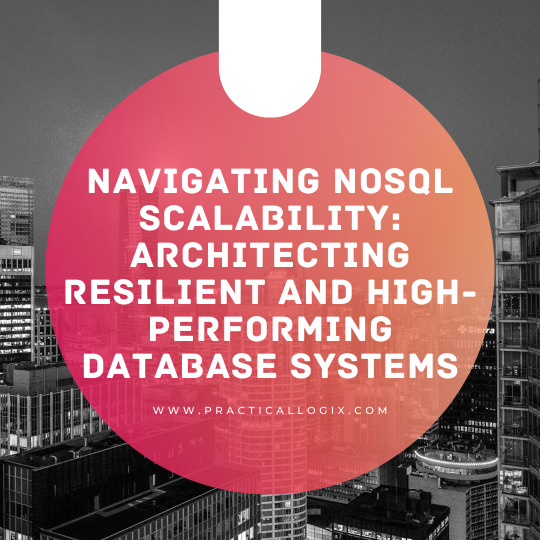
Understanding Scalable NoSQL Databases:
Scalable NoSQL databases have emerged as a transformative force in the field of data management. In contrast to conventional relational databases, NoSQL databases are purpose-built to handle extensive volumes of structured, semi-structured, and unstructured data. They offer unparalleled flexibility and horizontal scalability, enabling businesses to seamlessly accommodate growth by seamlessly incorporating additional servers or nodes into the system.
Advantages of Scalable NoSQL Databases:
Horizontal Scalability: Scalable NoSQL databases are designed to scale out, distributing data across multiple nodes. This approach enables seamless expansion as data volumes grow, ensuring optimal performance without compromising speed.
Flexibility: NoSQL databases are highly capable of handling a wide array of data types, which makes them particularly suitable for applications that involve diverse data structures. These can include social media interactions, sensor data, and user-generated content.
High Performance: The distributed nature of NoSQL databases facilitates parallel processing, leading to accelerated data retrieval and query performance. This is particularly beneficial for applications that demand real-time responsiveness.
Availability and Resilience: NoSQL databases frequently provide integrated functionalities for data replication and fault tolerance, guaranteeing continuous data accessibility in the presence of hardware failures or network disruptions.
Architecting Resilient and High-Performing Database Systems:
Data Modeling for Scalability: NoSQL databases provide the flexibility of schema designs. When designing your data model, prioritize access patterns and query requirements. Enhance performance by denormalizing and optimizing data storage to minimize joins. Furthermore, optimize data distribution by implementing data partitioning to evenly distribute data across nodes.
Choose the Right NoSQL Database Type: There exist various types of NoSQL databases, encompassing document-oriented, key-value, column-family, and graph databases. It is crucial to select the type that most effectively aligns with your data structure and application requirements.
Replication and Sharding: To ensure data availability and distribute the workload across multiple nodes, it is advisable to implement data replication and sharding strategies. Replication safeguards against data loss by maintaining copies of data on different servers, while sharding divides the data into smaller, more manageable chunks.
Load Balancing: Employ load balancers to evenly distribute incoming requests across nodes, preventing server overload and ensuring optimal performance.
Caching Mechanisms: Utilize caching mechanisms such as in-memory databases or caching layers to optimize data retrieval speed and alleviate the burden on the primary database.
Monitoring and Optimization: Consistently monitor the performance of your database, meticulously identifying bottlenecks and areas for improvement. Utilize performance metrics to optimize your database configuration and scaling strategies.
Backup and Disaster Recovery: Implement reliable backup and disaster recovery mechanisms to ensure the safety of data in the event of unforeseen failures. Regularly conduct testing and updates to your backup and recovery procedures.
Scalability Testing: Prior to deployment, it is advisable to perform scalability testing to evaluate the performance of your database system under increasing workloads. This process enables the identification of potential limitations and facilitates the implementation of necessary adjustments.
In conclusion, effectively navigating scalable NoSQL databases offers a robust solution for effectively managing modern data challenges. By leveraging the advantages of NoSQL databases and implementing solid architectural strategies, businesses can design resilient and high-performing database systems that seamlessly handle expanding data volumes and deliver optimal performance. Whether you are constructing an e-commerce platform, a real-time analytics application, or a social media platform, embracing scalable NoSQL databases can position your business for success in the era of big data.
0 notes
Text

#Scrabble
Crack the Code! 🔢
Guess the scrambled tech word of the day! 🚀💡
Comments your answer below👇
💻 Explore insights on the latest in #technology on our Blog Page 👉 https://simplelogic-it.com/blogs/
🚀 Ready for your next career move? Check out our #careers page for exciting opportunities 👉 https://simplelogic-it.com/careers/
#scrabblechallenge#scrabble#scrabbletiles#scrabbleart#scrabbleframe#scrabbleletters#words#boardgame#fun#scrabblecraft#nosql#database#data#unstructureddata#scalable#program#webpage#simplelogic#makingitsimple#simplelogicit#makeitsimple#itservices#itconsulting
0 notes
Text
Exploring the Power of Amazon Web Services: Top AWS Services You Need to Know
In the ever-evolving realm of cloud computing, Amazon Web Services (AWS) has established itself as an undeniable force to be reckoned with. AWS's vast and diverse array of services has positioned it as a dominant player, catering to the evolving needs of businesses, startups, and individuals worldwide. Its popularity transcends boundaries, making it the preferred choice for a myriad of use cases, from startups launching their first web applications to established enterprises managing complex networks of services. This blog embarks on an exploratory journey into the boundless world of AWS, delving deep into some of its most sought-after and pivotal services.

As the digital landscape continues to expand, understanding these AWS services and their significance is pivotal, whether you're a seasoned cloud expert or someone taking the first steps in your cloud computing journey. Join us as we delve into the intricate web of AWS's top services and discover how they can shape the future of your cloud computing endeavors. From cloud novices to seasoned professionals, the AWS ecosystem holds the keys to innovation and transformation.
Amazon EC2 (Elastic Compute Cloud): The Foundation of Scalability At the core of AWS's capabilities is Amazon EC2, the Elastic Compute Cloud. EC2 provides resizable compute capacity in the cloud, allowing you to run virtual servers, commonly referred to as instances. These instances serve as the foundation for a multitude of AWS solutions, offering the scalability and flexibility required to meet diverse application and workload demands. Whether you're a startup launching your first web application or an enterprise managing a complex network of services, EC2 ensures that you have the computational resources you need, precisely when you need them.
Amazon S3 (Simple Storage Service): Secure, Scalable, and Cost-Effective Data Storage When it comes to storing and retrieving data, Amazon S3, the Simple Storage Service, stands as an indispensable tool in the AWS arsenal. S3 offers a scalable and highly durable object storage service that is designed for data security and cost-effectiveness. This service is the choice of businesses and individuals for storing a wide range of data, including media files, backups, and data archives. Its flexibility and reliability make it a prime choice for safeguarding your digital assets and ensuring they are readily accessible.
Amazon RDS (Relational Database Service): Streamlined Database Management Database management can be a complex task, but AWS simplifies it with Amazon RDS, the Relational Database Service. RDS automates many common database management tasks, including patching, backups, and scaling. It supports multiple database engines, including popular options like MySQL, PostgreSQL, and SQL Server. This service allows you to focus on your application while AWS handles the underlying database infrastructure. Whether you're building a content management system, an e-commerce platform, or a mobile app, RDS streamlines your database operations.
AWS Lambda: The Era of Serverless Computing Serverless computing has transformed the way applications are built and deployed, and AWS Lambda is at the forefront of this revolution. Lambda is a serverless compute service that enables you to run code without the need for server provisioning or management. It's the perfect solution for building serverless applications, microservices, and automating tasks. The unique pricing model ensures that you pay only for the compute time your code actually uses. This service empowers developers to focus on coding, knowing that AWS will handle the operational complexities behind the scenes.
Amazon DynamoDB: Low Latency, High Scalability NoSQL Database Amazon DynamoDB is a managed NoSQL database service that stands out for its low latency and exceptional scalability. It's a popular choice for applications with variable workloads, such as gaming platforms, IoT solutions, and real-time data processing systems. DynamoDB automatically scales to meet the demands of your applications, ensuring consistent, single-digit millisecond latency at any scale. Whether you're managing user profiles, session data, or real-time analytics, DynamoDB is designed to meet your performance needs.
Amazon VPC (Virtual Private Cloud): Tailored Networking for Security and Control Security and control over your cloud resources are paramount, and Amazon VPC (Virtual Private Cloud) empowers you to create isolated networks within the AWS cloud. This isolation enhances security and control, allowing you to define your network topology, configure routing, and manage access. VPC is the go-to solution for businesses and individuals who require a network environment that mirrors the security and control of traditional on-premises data centers.
Amazon SNS (Simple Notification Service): Seamless Communication Across Channels Effective communication is a cornerstone of modern applications, and Amazon SNS (Simple Notification Service) is designed to facilitate seamless communication across various channels. This fully managed messaging service enables you to send notifications to a distributed set of recipients, whether through email, SMS, or mobile devices. SNS is an essential component of applications that require real-time updates and notifications to keep users informed and engaged.
Amazon SQS (Simple Queue Service): Decoupling for Scalable Applications Decoupling components of a cloud application is crucial for scalability, and Amazon SQS (Simple Queue Service) is a fully managed message queuing service designed for this purpose. It ensures reliable and scalable communication between different parts of your application, helping you create systems that can handle varying workloads efficiently. SQS is a valuable tool for building robust, distributed applications that can adapt to changes in demand.
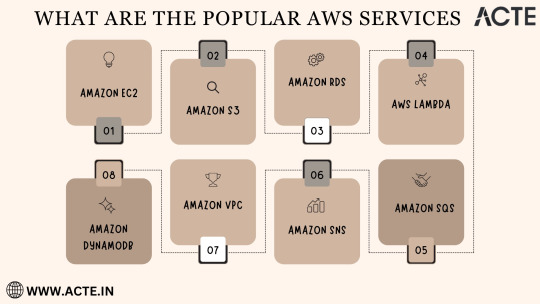
In the rapidly evolving landscape of cloud computing, Amazon Web Services (AWS) stands as a colossus, offering a diverse array of services that address the ever-evolving needs of businesses, startups, and individuals alike. AWS's popularity transcends industry boundaries, making it the go-to choice for a wide range of use cases, from startups launching their inaugural web applications to established enterprises managing intricate networks of services.
To unlock the full potential of these AWS services, gaining comprehensive knowledge and hands-on experience is key. ACTE Technologies, a renowned training provider, offers specialized AWS training programs designed to provide practical skills and in-depth understanding. These programs equip you with the tools needed to navigate and excel in the dynamic world of cloud computing.
With AWS services at your disposal, the possibilities are endless, and innovation knows no bounds. Join the ever-growing community of cloud professionals and enthusiasts, and empower yourself to shape the future of the digital landscape. ACTE Technologies is your trusted guide on this journey, providing the knowledge and support needed to thrive in the world of AWS and cloud computing.
8 notes
·
View notes
Text
Mastering the Art of Hiring MERN Stack Programmers: A Step-by-Step Guide
The MERN stack is a popular technology stack. It is an acronym that stands for MongoDB, Express.js, React, and Node.js. Each component of the MERN stack serves a specific purpose in the development process. MongoDB is a NoSQL database that stores data in a JSON-like format, making it flexible and scalable. Express.js is a web application framework for Node.js that provides a set of features for building web applications and APIs. React is a JavaScript library for building user interfaces, and it allows developers to create reusable UI components. Node.js is a server-side JavaScript runtime that allows developers to build scalable network applications. The MERN stack is known for its flexibility, efficiency, and performance. It allows developers to build full-stack applications using JavaScript, which makes the development process more streamlined and cohesive. Additionally, the MERN stack is well-suited for building real-time applications and single-page applications (SPAs). With its robust set of tools and technologies, the MERN stack has become a popular choice for businesses looking to develop modern, responsive web applications.
The Benefits of Hiring MERN Stack Programmers
Hiring MERN stack programmers can offer numerous benefits to businesses looking to develop web applications. MERN stack programmers are skilled in using MongoDB, Express.js, React, and Node.js to build dynamic and responsive web applications. They are proficient in JavaScript and have a deep understanding of the MERN stack architecture, making them valuable assets to any development team. MERN stack programmers are also well-versed in modern web development practices and can leverage the latest tools and technologies to build high-quality applications. They are capable of developing scalable and efficient web applications that can handle large amounts of data and traffic. Additionally, MERN stack programmers are adept at building real-time applications and SPAs, which are increasingly in demand in today's digital landscape. Furthermore, hiring MERN stack programmers can lead to faster development cycles and reduced time-to-market for web applications. Their expertise in the MERN stack allows them to build applications more efficiently, resulting in cost savings and improved productivity for businesses. Overall, hiring MERN stack programmers can provide businesses with the technical expertise and skills needed to develop modern, responsive web applications.
Where to Find Qualified MERN Stack Programmers
Finding qualified MERN stack programmers can be a challenging task, but there are several avenues businesses can explore to locate top talent. One option is to utilize online job boards and platforms specifically tailored to tech professionals, such as GitHub Jobs, Stack Overflow Jobs, and AngelList. These platforms allow businesses to post job listings and connect with experienced MERN stack programmers who are actively seeking new opportunities. Another option is to partner with specialized tech recruitment agencies that have access to a network of skilled MERN stack programmers. These agencies can help businesses identify and recruit top talent by leveraging their industry connections and expertise in the tech sector. Additionally, businesses can attend tech conferences, meetups, and networking events to connect with MERN stack programmers and build relationships within the tech community. Furthermore, businesses can explore freelance platforms such as Upwork and Toptal to find qualified MERN stack programmers who are available for short-term or project-based work. These platforms provide businesses with access to a global pool of tech talent and allow them to review portfolios and work samples before making hiring decisions. Overall, there are several avenues businesses can explore to find qualified MERN stack programmers, each with its own unique advantages and considerations.
How to Evaluate MERN Stack Programmers
Evaluating MERN stack programmers requires a comprehensive approach that takes into account their technical skills, experience, and cultural fit within the organization. One way to assess their technical proficiency is by conducting coding assessments or technical interviews that test their knowledge of JavaScript, MongoDB, Express.js, React, and Node.js. These assessments can help businesses gauge a candidate's ability to solve complex problems and write clean, efficient code using the MERN stack. Another important aspect to consider when evaluating MERN stack programmers is their experience with building real-world applications using the MERN stack. Reviewing their portfolio and work samples can provide insight into the quality of their previous projects and their ability to deliver high-quality web applications. Additionally, businesses can ask candidates about their experience with specific tools and technologies within the MERN stack, such as Redux for state management in React applications or Mongoose for interacting with MongoDB. Cultural fit is also an important factor to consider when evaluating MERN stack programmers. Businesses should assess a candidate's communication skills, teamwork abilities, and willingness to learn and adapt within a dynamic development environment. Conducting behavioral interviews or team-based exercises can help businesses gauge a candidate's interpersonal skills and how well they align with the company's values and culture. Overall, evaluating MERN stack programmers requires a holistic approach that considers their technical skills, experience, and cultural fit within the organization.
Interviewing MERN Stack Programmers
Interviewing MERN stack programmers requires careful preparation and consideration of the specific skills and qualities needed for the role. One approach is to conduct technical interviews that assess a candidate's knowledge of JavaScript, MongoDB, Express.js, React, and Node.js. These interviews can include coding exercises, problem-solving scenarios, or discussions about best practices for building web applications using the MERN stack. Another important aspect of interviewing MERN stack programmers is assessing their experience with building real-world applications and their ability to work within a team environment. Asking candidates about their previous projects, challenges they faced, and how they collaborated with other team members can provide insight into their practical skills and teamwork abilities. Additionally, businesses can use behavioral interviews to assess a candidate's communication skills, problem-solving abilities, and how well they align with the company's values and culture. Furthermore, businesses should consider conducting interviews that focus on specific tools and technologies within the MERN stack, such as Redux for state management in React applications or Mongoose for interacting with MongoDThese interviews can help businesses gauge a candidate's depth of knowledge in key areas of the MERN stack and their ability to leverage these tools effectively in real-world scenarios. Overall, interviewing MERN stack programmers requires a comprehensive approach that assesses their technical skills, practical experience, and cultural fit within the organization.
Onboarding MERN Stack Programmers
Onboarding MERN stack programmers is an important process that sets the stage for their success within the organization. One approach is to provide them with comprehensive training on the specific tools and technologies within the MERN stack, such as Redux for state management in React applications or Mongoose for interacting with MongoDThis training can help new hires become familiar with the company's development environment and best practices for building web applications using the MERN stack. Another important aspect of onboarding MERN stack programmers is integrating them into the development team and providing opportunities for collaboration and knowledge sharing. Pairing new hires with experienced team members or mentors can help them acclimate to the company's culture and development processes while also providing them with valuable guidance and support as they ramp up on new projects. Furthermore, businesses should consider providing new hires with access to resources such as documentation, code repositories, and development tools that will help them navigate their day-to-day responsibilities more effectively. This can include access to internal wikis or knowledge bases that contain information about the company's development processes, coding standards, and best practices for working with the MERN stack. Overall, onboarding MERN stack programmers requires a thoughtful approach that provides them with the training, support, and resources needed to succeed within the organization.
Retaining MERN Stack Programmers
Retaining MERN stack programmers requires ongoing efforts to support their professional growth, provide meaningful work opportunities, and foster a positive work environment. One approach is to offer professional development opportunities such as training programs, workshops, or certifications that allow MERN stack programmers to expand their skills and stay current with industry trends. This can help them feel valued within the organization and provide them with opportunities for career advancement. Another important aspect of retaining MERN stack programmers is providing them with challenging and meaningful work that allows them to leverage their skills and contribute to impactful projects. Offering opportunities for ownership over projects or involvement in decision-making processes can help keep MERN stack programmers engaged and motivated within their roles. Furthermore, fostering a positive work environment that values open communication, collaboration, and work-life balance can contribute to higher job satisfaction among MERN stack programmers. Providing opportunities for team-building activities, social events, or flexible work arrangements can help create a supportive and inclusive culture that encourages retention. Overall, retaining MERN stack programmers requires ongoing efforts to support their professional growth, provide meaningful work opportunities, and foster a positive work environment that values their contributions. By investing in their development and well-being, businesses can increase retention rates among their MERN stack programmers and build a strong foundation for long-term success within their development teams.
2 notes
·
View notes
Text
The Dynamic Role of Full Stack Developers in Modern Software Development
Introduction: In the rapidly evolving landscape of software development, full stack developers have emerged as indispensable assets, seamlessly bridging the gap between front-end and back-end development. Their versatility and expertise enable them to oversee the entire software development lifecycle, from conception to deployment. In this insightful exploration, we'll delve into the multifaceted responsibilities of full stack developers and uncover their pivotal role in crafting innovative and user-centric web applications.
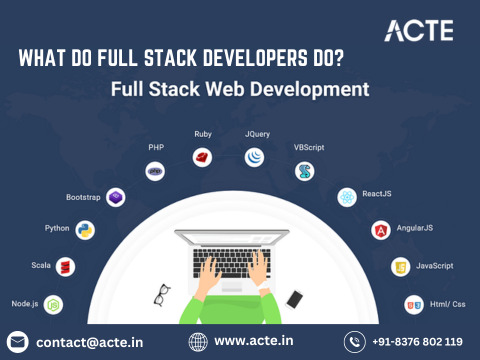
Understanding the Versatility of Full Stack Developers:
Full stack developers serve as the linchpins of software development teams, blending their proficiency in front-end and back-end technologies to create cohesive and scalable solutions. Let's explore the diverse responsibilities that define their role:
End-to-End Development Mastery: At the core of full stack development lies the ability to navigate the entire software development lifecycle with finesse. Full stack developers possess a comprehensive understanding of both front-end and back-end technologies, empowering them to conceptualize, design, implement, and deploy web applications with efficiency and precision.
Front-End Expertise: On the front-end, full stack developers are entrusted with crafting engaging and intuitive user interfaces that captivate audiences. Leveraging their command of HTML, CSS, and JavaScript, they breathe life into designs, ensuring seamless navigation and an exceptional user experience across devices and platforms.
Back-End Proficiency: In the realm of back-end development, full stack developers focus on architecting the robust infrastructure that powers web applications. They leverage server-side languages and frameworks such as Node.js, Python, or Ruby on Rails to handle data storage, processing, and authentication, laying the groundwork for scalable and resilient applications.
Database Management Acumen: Full stack developers excel in database management, designing efficient schemas, optimizing queries, and safeguarding data integrity. Whether working with relational databases like MySQL or NoSQL databases like MongoDB, they implement storage solutions that align with the application's requirements and performance goals.

API Development Ingenuity: APIs serve as the conduits that facilitate seamless communication between different components of a web application. Full stack developers are adept at designing and implementing RESTful or GraphQL APIs, enabling frictionless data exchange between the front-end and back-end systems.
Testing and Quality Assurance Excellence: Quality assurance is paramount in software development, and full stack developers take on the responsibility of testing and debugging web applications. They devise and execute comprehensive testing strategies, identifying and resolving issues to ensure the application meets stringent performance and reliability standards.
Deployment and Maintenance Leadership: As the custodians of web applications, full stack developers oversee deployment to production environments and ongoing maintenance. They monitor performance metrics, address security vulnerabilities, and implement updates and enhancements to ensure the application remains robust, secure, and responsive to user needs.
Conclusion: In conclusion, full stack developers embody the essence of versatility and innovation in modern software development. Their ability to seamlessly navigate both front-end and back-end technologies enables them to craft sophisticated and user-centric web applications that drive business growth and enhance user experiences. As technology continues to evolve, full stack developers will remain at the forefront of digital innovation, shaping the future of software development with their ingenuity and expertise.
#full stack course#full stack developer#full stack software developer#full stack training#full stack web development
2 notes
·
View notes